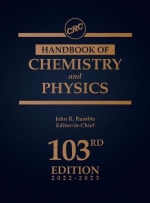Tab Article
High Quality Science requires High Quality Data! Today, more than ever, the CRC Handbook of Chemistry and Physics is critical in ensuring that researchers, educators, and students have the highest quality data for chemical compounds and physical particles. Available both in print and online, the Handbook covers 390 chemistry, physics, and related subjects organized in easy-to-find, well-organized tables. Every year, new reported data and new scientific areas are added, making the Handbook the largest comprehensive physical science data source available anywhere. Handbook features include:
- All data reviewed and evaluated by subject matter experts
- Standardized chemical names, structures, property names, and property units
- Important information on subjects such as chemical and laboratory safety, and nomenclature
- Chemical and physical data critical for fields such as environmental science, bio-medical chemistry, organic and inorganic chemistry, materials innovation, geo- and astrophysics, and solid-state science
- Digital tools in our Online Edition to analyze, graph, process, and exploit our data content


